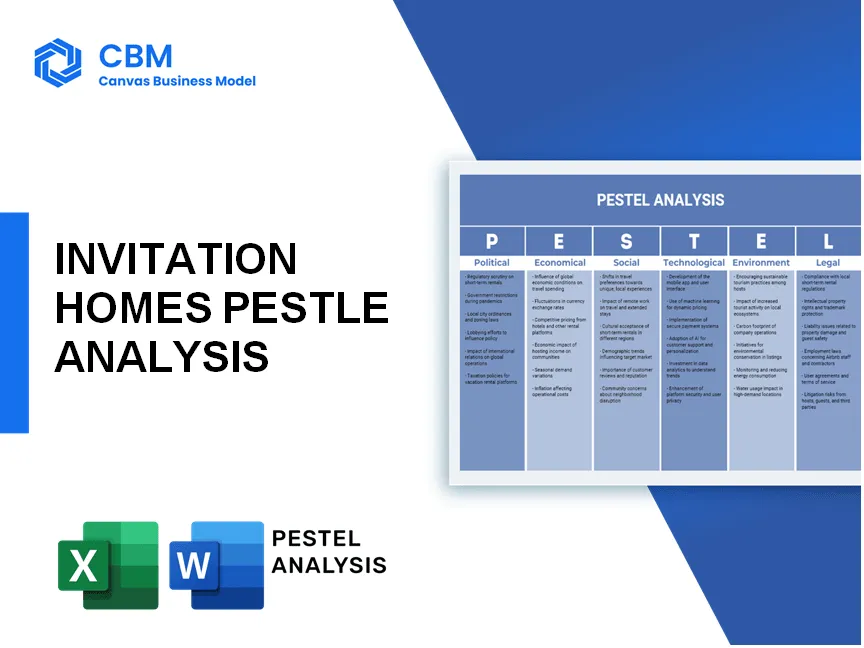In the dynamic world of real estate, understanding the myriad factors that influence a company like Invitation Homes is crucial. Through a detailed PESTLE analysis, we uncover how the ever-changing political, economic, sociological, technological, legal, and environmental landscapes shape the business of acquiring, rehabilitating, and leasing single-family homes. From navigating local zoning laws to harnessing the latest property management technologies, Invitation Homes stands at the intersection of opportunity and challenge in a thriving rental market. Dive deeper below to explore these facets in detail.
PESTLE Analysis: Political factors
Government policies on housing and real estate impact business operations.
In 2022, the U.S. Department of Housing and Urban Development (HUD) allocated approximately $10.4 billion in funding to various housing programs. The impact of governmental policies, such as the Low-Income Housing Tax Credit, enables Invitation Homes to leverage tax incentives to enhance their investment in rehabilitated properties. The Biden administration's focus on affordable housing has led to proposals that could increase funding for housing assistance programs, potentially benefiting companies engaged in similar real estate operations.
Local zoning laws affect property acquisition and rehabilitation processes.
Local zoning regulations vary widely across municipalities, which can impact property acquisition strategies. For instance, cities like Los Angeles have strict zoning laws, leading to an average time of 12 months for permit approvals for rehabilitation projects, according to the Los Angeles Department of City Planning. Invitation Homes operates in regions where local governments are increasingly relaxing zoning restrictions to promote development, such as a 25% increase in allowable density in certain urban areas since 2020.
Political stability influences market confidence in real estate investments.
Political stability in the U.S. is generally high, with the country scoring 82.8 out of 100 on the Political Stability Index according to the World Bank (2021). This score indicates a favorable environment for real estate investment. However, tensions surrounding policy changes can cause fluctuations in the market, as evidenced by a 10% decline in real estate stocks during the 2021 electoral cycle.
Urban development strategies by local governments may create opportunities.
The American Planning Association reported that cities are increasingly investing in urban redevelopment, with approximately $200 billion allocated to urban infrastructure improvements in the past five years. Invitation Homes can capitalize on these strategies by focusing on purchasing homes in revitalization areas, benefiting from increased property values and reduced acquisition costs. For instance, the city of Atlanta's plan to invest $100 million in affordable housing development over the next five years creates potential opportunities for acquisition and rehabilitation.
Regulations regarding housing standards can affect operational costs.
Regulatory frameworks regarding safety and building standards have tightened over the years. For example, the National Housing Quality Standards enacted in 2021 have led to increased compliance costs, which can average between $5,000 to $10,000 per property for rehab undertaken in line with the new standards. This situation necessitates that Invitation Homes accounts for these additional operational costs when assessing potential acquisitions.
| Political Factor | Impact/Impact Amount | Data Source |
|---|---|---|
| HUD Funding Allocations | $10.4 billion | U.S. Department of Housing and Urban Development (2022) |
| Average Permit Approval Time | 12 months | Los Angeles Department of City Planning |
| Political Stability Index | 82.8 out of 100 | World Bank (2021) |
| Urban Development Investment | $200 billion | American Planning Association |
| Compliance Cost Range | $5,000 - $10,000 per property | National Housing Quality Standards (2021) |
[cbm_pestel_top]
PESTLE Analysis: Economic factors
Fluctuations in interest rates impact mortgage affordability for tenants
As of October 2023, the average interest rate for a 30-year fixed mortgage in the United States is approximately 7.6%. This reflects an increase from earlier in the year, where rates were around 6.0%. Higher interest rates can reduce the affordability of home mortgages for potential buyers, often pushing them into the rental market.
Economic downturns can increase foreclosure rates, benefiting property acquisition
According to data from CoreLogic, in 2023, foreclosure rates reached a national average of about 0.52%. This represents an increase from 0.29% in 2022. Invitation Homes may benefit from acquiring more homes in foreclosure situations during economic downturns, taking advantage of lower purchase prices.
Unemployment rates influence tenant demand and rental pricing
The unemployment rate in the United States as of September 2023 stands at 3.8%, indicating a relatively stable job market. However, fluctuations in this rate can lead to changes in tenant demand. Historical data shows that a rise in unemployment of 1% typically correlates with a 10-15% increase in rental vacancies.
Economic growth promotes increased demand for rental properties
The U.S. Gross Domestic Product (GDP) grew by 2.9% in the second quarter of 2023. Economic growth often leads to increased job creation, higher disposable incomes, and subsequently, an uptick in demand for rental properties. Population growth in urban areas further exacerbates the need for more rental housing.
Inflation affects operating costs and rental pricing strategies
As of August 2023, the Consumer Price Index (CPI) shows an inflation rate of 3.7%. This persistent inflation influences operating costs for property management, including maintenance, utilities, and repairs. As manager costs rise by approximately 4-5%, rental pricing strategies must adapt to maintain profitability.
| Economic Indicator | Current Value | Previous Year Value | Percentage Change |
|---|---|---|---|
| 30-Year Fixed Mortgage Rate | 7.6% | 6.0% | 26.67% |
| Foreclosure Rate | 0.52% | 0.29% | 79.31% |
| Unemployment Rate | 3.8% | 3.5% | 8.57% |
| GDP Growth Rate (Q2 2023) | 2.9% | 1.9% | 52.63% |
| Inflation Rate (CPI) | 3.7% | 8.5% | -56.47% |
PESTLE Analysis: Social factors
Sociological
Shifts in demographics, such as aging population, influence rental markets.
The U.S. Census Bureau reported that by 2030, all Baby Boomers will be over the age of 65, resulting in approximately 73 million seniors, up from 47 million in 2019. This demographic shift is contributing to a growing market for rental housing, particularly single-family rentals, which are often more appealing to older adults seeking flexibility.
Changing social attitudes towards renting versus owning affect business.
According to the Harvard Joint Center for Housing Studies, as of 2021, about 36% of U.S. households were renters, a significant increase from 31% in 2000. The 2021 National Association of Realtors survey highlighted that 71% of respondents believe renting provides more flexibility than owning.
Urbanization trends lead to higher demand for single-family rentals.
The U.S. urban population is projected to reach 90% by 2050, with significant implications for housing demand. The National Multifamily Housing Council noted that as of 2022, 52% of millennials are renting single-family homes, suggesting a trend toward urbanization and higher demand for rental properties in metropolitan areas.
Family structures evolving towards smaller households may impact property types needed.
The Pew Research Center outlines that the average household size in the U.S. is now approximately 2.5 persons, down from 3.1 in 1970. Small households increasingly prefer properties that cater to their needs, shifting the demand from larger homes to more efficient, manageable single-family rentals.
Consumer preferences for amenities and location are continuously evolving.
A survey conducted by Zillow in 2022 indicated that 62% of renters prioritize access to outdoor space, while 59% prioritize proximity to public transportation. Furthermore, the National Association of Home Builders reported in 2020 that 62% of millennials prefer urban areas and amenities that promote community interaction, influencing design and location of rental properties.
| Demographic Factor | Value | Source |
|---|---|---|
| Projected seniors (65 ) by 2030 | 73 million | U.S. Census Bureau |
| Percentage of U.S. households that are renters (2021) | 36% | Harvard Joint Center for Housing Studies |
| Millennials renting single-family homes (2022) | 52% | National Multifamily Housing Council |
| Average household size (2022) | 2.5 persons | Pew Research Center |
| Renters prioritizing outdoor space (2022) | 62% | Zillow |
PESTLE Analysis: Technological factors
Advancements in property management software streamline operations.
In 2022, property management software market size reached approximately $15.5 billion and is expected to grow at a CAGR of around 8.6% from 2023 to 2030. Major players include Yardi, AppFolio, and Buildium, which offer tools for lease tracking, maintenance management, and tenant screening.
Online platforms facilitate marketing and leasing to potential tenants.
As of 2023, the online rental market is projected to be valued at $19.8 billion, driven by platforms such as Zillow, Apartments.com, and Rent.com, which have millions of monthly visitors. Invitation Homes leverages these platforms for showcasing properties and increasing visibility.
Data analytics enhance decision-making for property acquisitions.
According to recent reports, the global big data analytics market in real estate is estimated to surpass $28.4 billion by 2026, creating substantial opportunities in predictive analytics and market trend analysis. Invitation Homes utilizes data analytics to assess neighborhood trends and optimize property portfolios.
Smart home technologies increase property value and tenant satisfaction.
A survey by the National Association of Home Builders in 2021 showed that 83% of homebuyers consider smart home technology a desirable feature. Properties equipped with smart technology can see a 5-10% increase in rental rates, enhancing tenant satisfaction and fostering longer lease terms.
Social media influences brand awareness and customer engagement.
As of 2023, approximately 73% of marketers believe that social media is effective for their businesses. Invitation Homes utilizes platforms such as Facebook, Instagram, and Twitter for marketing, contributing to an increase in lead generation. In 2022, the average cost per lead generated through social media was reported at $3.50, compared to $6.00 for traditional methods.
| Technology Category | Market Size ($ Billion) | Growth Rate (CAGR %) | Tenant Satisfaction Impact | Year |
|---|---|---|---|---|
| Property Management Software | 15.5 | 8.6 | N/A | 2022 |
| Online Rental Market | 19.8 | N/A | N/A | 2023 |
| Big Data Analytics in Real Estate | 28.4 | N/A | N/A | 2026 |
| Smart Home Technology Value Increase | N/A | N/A | 5-10% | 2021 |
| Social Media Marketing | N/A | N/A | 73% | 2023 |
PESTLE Analysis: Legal factors
Compliance with housing regulations is crucial for operational integrity.
Invitation Homes must comply with various federal, state, and local housing regulations, which include building codes, safety standards, and occupancy limits. Violations can result in fines, reduced revenue, and damage to the company's reputation.
According to the National Apartment Association, apartment industry compliance costs can amount to approximately $330 per apartment per year. Given that Invitation Homes operates in a substantial portfolio, potential compliance costs can aggregate significantly across its holdings.
Lease agreements must adhere to local and federal laws.
Lease agreements must align with the various regulations that govern rental properties, including disclosure of lead-based paint hazards, tenant rights, and security deposit limits. For example, the U.S. Department of Housing and Urban Development (HUD) mandates that landlords adhere to the Fair Housing Act, which prohibits discrimination.
In California, the maximum allowable security deposit for an unfurnished residential rental unit is two months’ rent, while it is three months for a furnished unit.
Fair housing laws impact tenant selection and property management policies.
Fair housing laws are fundamental to Invitation Homes' tenant selection process. Approximately 42% of eviction cases in the U.S. are related to issues stemming from fair housing violations, which can lead to lawsuits costing an average of $25,000 per case.
Compliance with these laws not only ensures legal adherence but also fosters a more diverse tenant base.
Understanding landlord-tenant laws is essential to mitigate legal disputes.
Landlord-tenant laws vary significantly by state. In New York, landlords must provide a notice of non-renewal at least 30 days prior to lease expiration. Failing to do so can result in legal disputes and financial penalties.
Additionally, in Florida, the statute allows landlords to retain security deposits for damages beyond normal wear and tear, which necessitates clear documentation on property conditions.
Ongoing changes in legislation may affect rental pricing or property maintenance standards.
Recent legislation, such as the COVID-19 eviction moratorium, has temporarily altered the landscape of rental management. For example, the National Multifamily Housing Council reported that as of August 2021, 3.2 million renters remained in arrears, influencing rental income streams.
Furthermore, proposed changes to zoning laws in major cities could impact property availability for rental, directly influencing market prices. The affordability crisis in urban areas has prompted cities like San Francisco to consider policies that could significantly alter rental pricing structures.
| Aspect | Details |
|---|---|
| Average Compliance Costs per Apartment | $330 |
| Potential Eviction Case Cost | $25,000 |
| Percentage of Evictions Due to Fair Housing Violations | 42% |
| Notice Requirement in New York | 30 days |
| Renters in Arrears (August 2021) | 3.2 million |
PESTLE Analysis: Environmental factors
Sustainable practices can enhance property appeal and reduce operational costs.
In 2022, properties utilizing energy-efficient appliances and sustainable materials showed a 10-15% increase in rental prices compared to traditional homes.
Operating costs can decrease by up to 20% through energy-saving measures such as LED lighting and high-efficiency HVAC systems.
Environmental regulations may impact property renovations and management.
As of 2023, regulations under the Energy Policy Act (EPA) have mandated energy audits for properties to comply with renewable energy standards, impacting an estimated 30% of Invitation Homes' renovation projects.
Non-compliance can result in fines averaging $15,000 per property.
Climate change considerations affect property risk assessments and insurance.
According to the National Oceanic and Atmospheric Administration (NOAA), extreme weather events have increased property insurance costs by 25-50% in high-risk areas, affecting locations of Invitation Homes.
Climate risk assessments can boost risk-adjusted returns by approximately 8%.
Demand for energy-efficient homes is growing among tenants.
As of 2023, surveys indicate that 86% of renters consider energy efficiency important when choosing a home, with a willingness to pay an additional $100-200 per month for energy-efficient features.
Location-specific environmental factors can influence property value and desirability.
Properties in areas with high flood risk have seen a decrease in value by an average of 7% in the past three years. In contrast, homes located in LEED-certified neighborhoods command a premium of up to 20%.
| Factor | Impact | Statistics |
|---|---|---|
| Sustainable Practices | Enhanced appeal & lower costs | 10-15% increase in rental prices; 20% decrease in operational costs |
| Environmental Regulations | Impact on renovations & compliance costs | 30% renovation projects affected; fines average $15,000 |
| Climate Change | Risk assessments & insurance costs | 25-50% increase in insurance costs; 8% boost in returns |
| Energy Efficiency Demand | Tenant attraction | 86% renters prioritize efficiency; $100-200 willingness to pay |
| Location-Specific Value Factors | Influence on property values | 7% value decrease in flood-prone areas; 20% premium in LEED neighborhoods |
In conclusion, Invitation Homes operates within a dynamic landscape shaped by multifaceted factors. From political policies to environmental considerations, each element plays a crucial role in defining the company's strategies and opportunities. By navigating these complexities, Invitation Homes can effectively respond to shifting market demands and enhance its position as a leader in the single-family rental market. The interplay of these driving forces not only influences operational decisions but also shapes the future of housing, making it imperative for the company to remain agile and informed.
[cbm_pestel_bottom]












